2008 MERCEDES-BENZ SL ROADSTER air condition
[x] Cancel search: air conditionPage 6 of 317
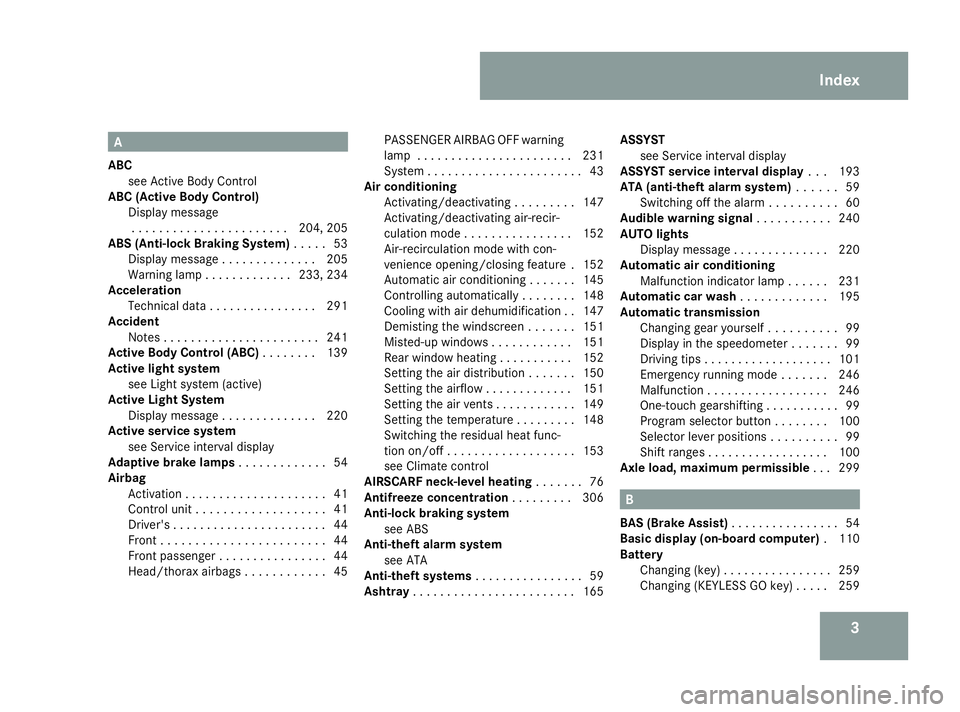
3A
ABC see Active Body Control
ABC (Active Bod yControl)
Display message ....................... 204, 205
ABS (Anti-lock Braking System) .....53
Display message .............. 205
Warning lamp ............. 233, 234
Acceleration
Technical data ................ 291
Accident
Notes ....................... 241
Active Body Control (ABC) ........139
Active light system see Ligh tsystem (active)
Active Light System
Display message .............. 220
Active service system
see Service interva ldisplay
Adaptive brake lamps .............54
Airbag Activation ..................... 41
Control unit ................... 41
Driver's ....................... 44
Front ........................ 44
Front passenger ................ 44
Head/thorax airbags ............45PASSENGER AIRB
AGOFF warning
lamp ....................... 231
System ....................... 43
Ai rc onditioning
Activating/deactivating .........147
Activating/deactivating air-recir-
culation mode ................ 152
Air-recirculation mode with con-
venience opening/closing feature .152
Automatic airc onditioning.......145
Controlling automatically ........148
Cooling with aird ehumidification..147
Demisting the windscreen .......151
Misted-up windows ............151
Rea rwindow heating ........... 152
Setting the aird istribution.......150
Setting the airflow .............151
Setting the airv ents............ 149
Setting the temperature .........148
Switching the residua lheatfunc-
tion on/off ................... 153
see Climate control
AIRSCARF neck-level heating .......76
Antifreez econcentration .........306
Anti-loc kbraking system
see ABS
Anti-theft alarm system
see ATA
Anti-theft systems ................ 59
Ashtray ........................ 165ASSYST
see Service interva ldisplay
ASSYST service interval display ...193
ATA (anti-theft alarm system) ......59
Switching off the alarm ..........60
Audibl ewarning signal ........... 240
AUTO lights Display message .............. 220
Automatic air conditioning
Malfunction indicator lamp ......231
Automatic car wash .............195
Automatic transmission Changing gea ryoursel f.......... 99
Display in the speedomete r.......99
Driving tip s.................. .101
Emergency running mode .......246
Malfunction .................. 246
One-touch gearshifting ...........99
Program selector button ........100
Selector leve rpositions .......... 99
Shift ranges .................. 100
Axl eload, maximum permissible ...299 B
BAS (Brake Assist) ................ 54
Basic display (on-board computer) .110
Battery Changing (key )................ 259
Changing (KEYLESS GO key) .....259 Index
230_AKB; 5; 4, en-GB
bjanott,
Version: 2.9.6
2008-04-08T15:09:54+02:00
-Seite 3 Dateiname: 6515_3089_02_buchblock.pdf; preflight
Page 10 of 317
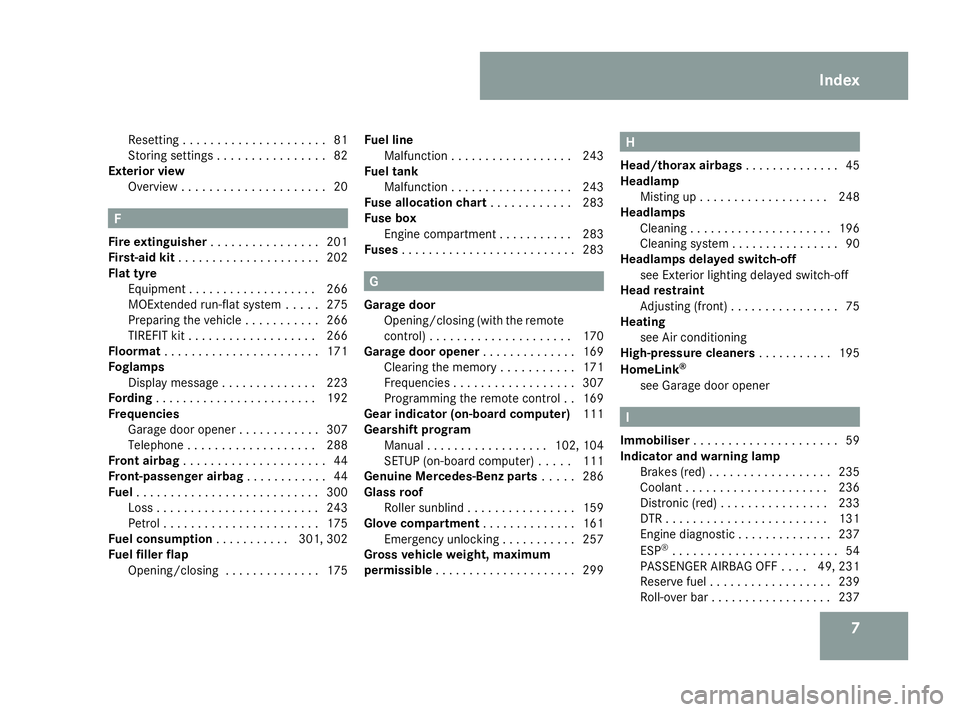
7
Resettin
g.................... .81
Storing settings ................ 82
Exterior view
Overview ..................... 20F
Fire extinguisher ................ 201
First-aid kit ..................... 202
Flat tyre Equipment ................... 266
MOExtended run-fla tsystem ..... 275
Preparing the vehicle ...........266
TIREFIT kit ................... 266
Floormat ....................... 171
Foglamps Display message .............. 223
Fording ........................ 192
Frequencies Garage door opene r............ 307
Telephone ................... 288
Fron tairbag ..................... 44
Front-passenger ai rbag ............ 44
Fuel ........................... 300
Loss ........................ 243
Petrol ....................... 175
Fue lcon sumption ........... 301, 302
Fue lfiller flap
Opening/closing .............. 175Fue
lline
Malfunction .................. 243
Fue ltank
Malfunction .................. 243
Fuse allocatio nchart ............ 283
Fuse box Engine compartment ...........283
Fuses .......................... 283 G
Garage door Opening/closing (with the remote
control) ..................... 170
Garage door opener ..............169
Clearing the memory ...........171
Frequencies .................. 307
Programming the remote control ..169
Gear indicator (on-board computer) 111
Gearshift program Manual .................. 102, 104
SETUP (on-board computer) .....111
Genuine Mercedes-Benz parts .....286
Glass roof Roller sunblind ................ 159
Glove compartment ..............161
Emergency unlocking ...........257
Gross vehiclew eight, maximum
permissible ..................... 299 H
Head/thorax airbags ..............45
Headlamp Misting up ................... 248
Headlamps
Cleaning ..................... 196
Cleaning system ................ 90
Headlamps delaye dswitch-off
see Exterior lighting delayed switch-off
Head restraint
Adjusting (front) ................ 75
Heating
see Air conditioning
High-pressure cleaners ...........195
HomeLink ®
see Garage door opener I
Immobiliser ..................... 59
Indicator an dwarning lamp
Brake s(red ).................. 235
Coolant ..................... 236
Distronic (red )................ 233
DTR ........................ 131
Engine diagnostic .............. 237
ESP ®
........................ 54
PASSENGER AIRB AGOFF .... 49, 231
Reserve fuel .................. 239
Roll-over bar .................. 237 Index
230_AKB; 5; 4, en-GB
bjanott,
Version: 2.9.6 2008-04-08T15:09:54+02:00-Seite 7 Dateiname: 6515_3089_02_buchblock.pdf; preflight
Page 35 of 317

Centre console
32 Upper section
Function Page
1 Locks the vehicle centrally
68
2 Unlock
sthe vehicle cen-
trally 68
3 Switches the hazar
dwarn-
ing lamps on/off 90
4 Adjusts the centr
eand side
air vents 149
5 Operates COMAN
D–see
separat eoperating instruc-
tions 109
6 Cup holder
,right 159
7
KEYLESS GO button* 73
8 Ashtray
165 Function Page
9 Operates the automatic air
conditioning
145
a Cup holder
,left 159At
ag lance
*optional
230_AKB; 5; 4, en-GB
bjanott
,V ersion: 2.9.6
2008-04-08T15:09:54+02:00
-Seite 32 Dateiname: 6515_3089_02_buchblock.pdf; preflight
Page 36 of 317
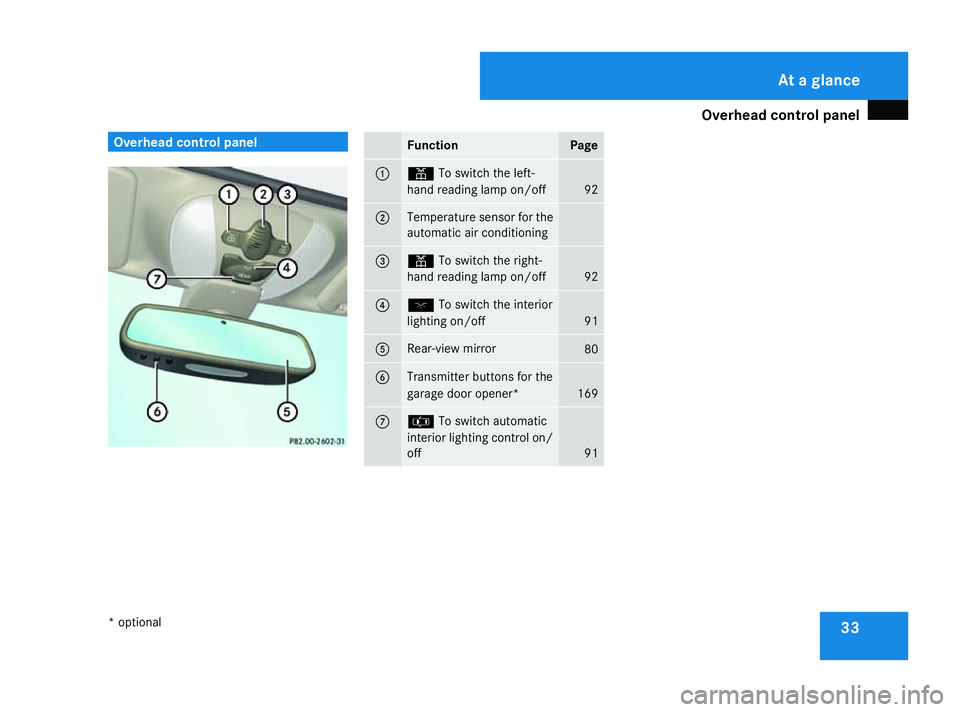
Overhea
dcontrol panel 33Overhea
dcontrol panel Function Page
1 X
To switch the left-
hand reading lamp on/off 92
2 Temperature sensor for the
automatic air conditioning
3 X
To switch the right-
hand reading lamp on/off 92
4 ð
To switch the interior
lightin gon/off 91
5 Rear-view mirror
80
6 Transmitter buttons for the
garage door opener*
169
7 ¤
To switch automatic
interior lightin gcontrol on/
off 91 At
ag lance
*o ptional
230_AKB
;5;4,en-GB
bjanott, Version:2.9.6
2008-04-08T15:09:54+02:0
0-Seite 33 Dateiname: 6515_3089_02_buchblock.pdf; preflight
Page 47 of 317
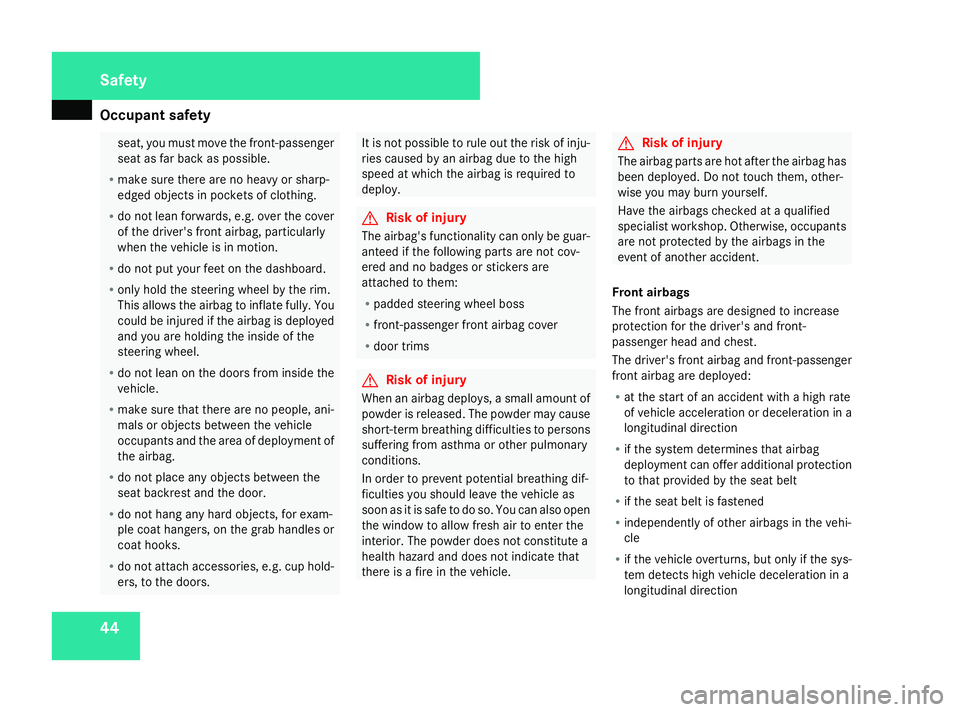
Occupant safety
44 seat, you must move the front-passenger
seat as far back as possible.
R make sure ther eare no heavy or sharp-
edged objects in pockets of clothing.
R do not lean forwards, e.g. over the cover
of the driver's fron tairbag, particularly
when the vehicle is in motion.
R do not put your feet on the dashboard.
R only hold the steering wheel by the rim.
This allows the airbag to inflat efully. You
could be injured if the airbag is deployed
and you are holding the inside of the
steering wheel.
R do not lean on the doors from inside the
vehicle.
R make sure that ther eare no people, ani-
mals or objects between the vehicle
occupants and the area of deployment of
the airbag.
R do not place any objects between the
seat backrest and the door.
R do not hang any hard objects, for exam-
ple coat hangers, on the grab handles or
coat hooks.
R do not attach accessories, e.g. cup hold-
ers, to the doors. It is not possible to rule out the risk of inju-
ries caused by an airbag due to the high
speed at which the airbag is required to
deploy. G
Risk of injury
The airbag's functionality can only be guar-
anteed if the following parts are not cov-
ered and no badges or stickers are
attached to them:
R padded steering wheel boss
R front-passenger fron tairbag cover
R door trims G
Risk of injury
When an airbag deploys, asmall amount of
powder is released. The powder may cause
short-term breathin gdifficulties to persons
sufferin gfrom asthma or other pulmonary
conditions.
In order to preven tpotential breathin gdif-
ficulties you should leave the vehicle as
soon as it is safe to do so. You can also open
the window to allow fresh air to enter the
interior. The powder does not constitute a
health hazard and does not indicat ethat
ther eisaf ire in the vehicle. G
Risk of injury
The airbag parts are hot after the airbag has
been deployed. Do not touch them ,other-
wise you may burn yourself.
Have the airbags checked at aqualified
specialist workshop. Otherwise, occupants
are not protected by the airbags in the
event of another accident.
Front airbags
The fron tairbags are designed to increase
protection for the driver's and front-
passenger head and chest.
The driver's fron tairbag and front-passenger
fron tairbag are deployed:
R at the start of an acciden twith ahigh rate
of vehicle acceleration or deceleration in a
longitudinal direction
R if the system determines that airbag
deployment can offer additional protection
to that provided by the seat belt
R if the seat belt is fastened
R independently of other airbags in the vehi-
cle
R if the vehicle overturns, but only if the sys-
tem detects high vehicle deceleration in a
longitudinal direction Safety
230_AKB
;5;4,en-GB
bjanott, Version:2.9.6
2008-04-08T15:09:54+02:0
0-Seite 44 Dateiname: 6515_3089_02_buchblock.pdf; preflight
Page 66 of 317
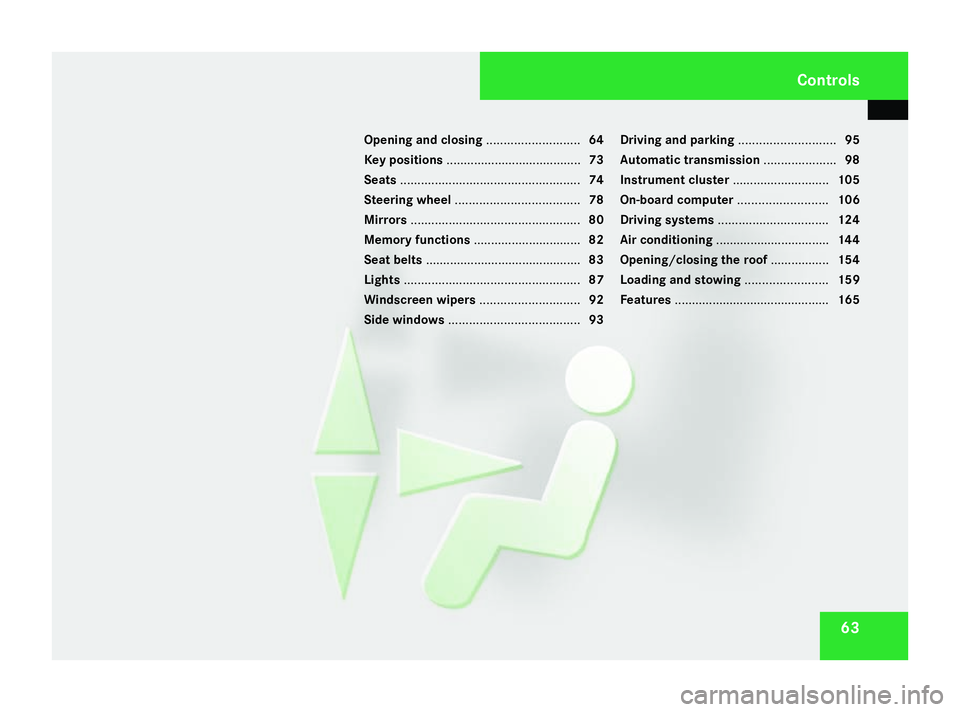
63
Opening and closing
...........................64
Key positions ....................................... 73
Seats .................................................... 74
Steering wheel .................................... 78
Mirrors ................................................. 80
Memor yfunctions ............................... 82
Seat belts ............................................. 83
Lights ................................................... 87
Windscreen wipers .............................92
Side windows ...................................... 93Driving and parking
............................95
Automatic transmission .....................98
Instrument cluster ............................105
On-boar dcomputer .......................... 106
Driving systems ................................ 124
Air conditioning ................................. 144
Opening/closing the roof .................154
Loading and stowing ........................159
Features ............................................. 165 Controls
230_AKB
;5;4,en-GB
bjanott, Version:2.9.6
2008-04-08T15:09:54+02:0
0-Seite 63 Dateiname: 6515_3089_02_buchblock.pdf; preflight
Page 77 of 317
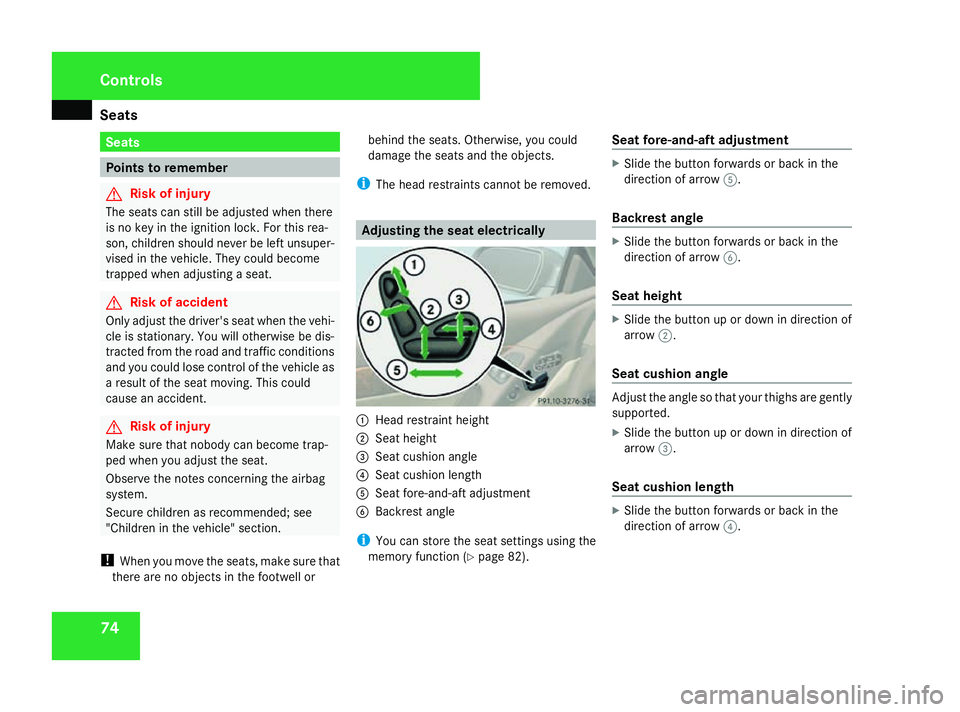
Seats
74 Seats
Points to remember
G
Risk of injury
The seats can still be adjusted when there
is no key in the ignition lock. For this rea-
son, children should never be left unsuper-
vised in the vehicle. They could become
trapped when adjusting aseat. G
Risk of accident
Only adjust the driver's seat when the vehi-
cle is stationary. You will otherwise be dis-
tracted from the road and traffic conditions
and you could lose control of the vehicle as
ar esult of the seat moving. This could
cause an accident. G
Risk of injury
Make sure that nobody can become trap-
ped when you adjust the seat.
Observe the notes concerning the airbag
system.
Secure children as recommended; see
"Children in the vehicle" section.
! When you move the seats, make sure that
there are no objectsint he footwell orbehind the seats. Otherwise, you could
damage the seats and the objects.
i The head restraint scannot be removed. Adjusting the seat electrically
1
Head restraint height
2 Seat height
3 Seat cushion angle
4 Seat cushion length
5 Seat fore-and-aft adjustment
6 Backrest angle
i You can store the seat settings using the
memory function (Y page 82). Seat fore-and-aft adjustment X
Slide the button forwards or back in the
direction of arrow 5.
Backrest angle X
Slide the button forwards or back in the
direction of arrow 6.
Seat height X
Slide the button up or down in direction of
arrow 2.
Seat cushiona ngle Adjust the angle so that yourt
highs are gently
supported.
X Slide the button up or down in direction of
arrow 3.
Seat cushionl ength X
Slide the button forwards or back in the
direction of arrow 4. Controls
230_AKB; 5; 4, en-GB
bjanott,
Version: 2.9.6
2008-04-08T15:09:54+02:00
-Seite 74 Dateiname: 6515_3089_02_buchblock.pdf; preflight
Page 89 of 317
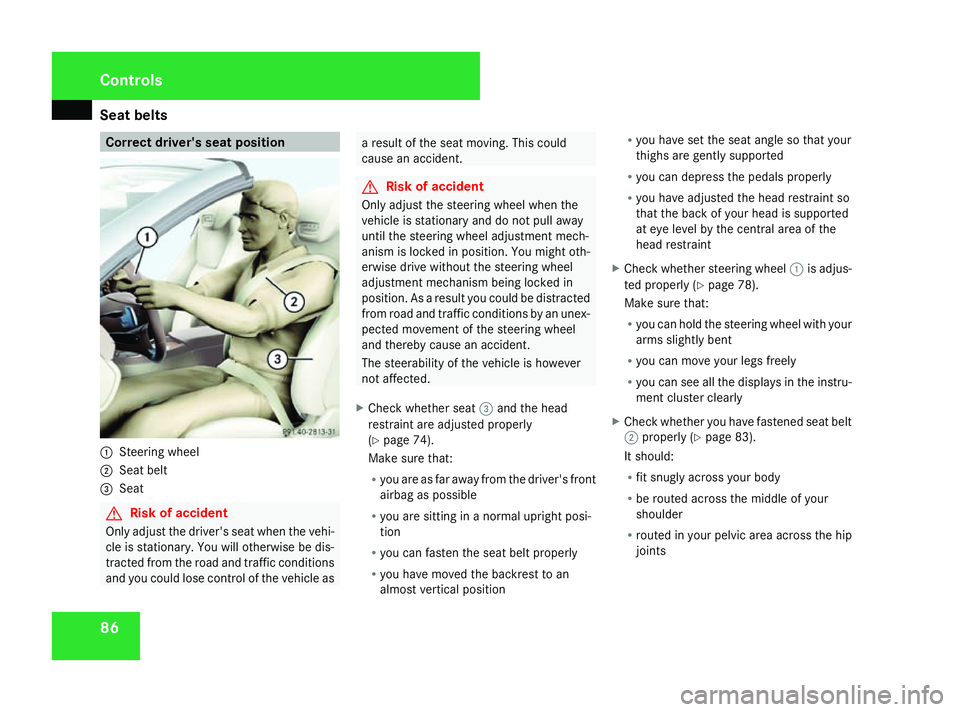
Seat belts
86 Correct driver's seat position
1
Steering wheel
2 Seat belt
3 Seat G
Risk of accident
Only adjust the driver's seat when the vehi-
cle is stationary. You will otherwise be dis-
tracted from the road and traffic conditions
and you could lose control of the vehicle as ar
esult of the seat moving. This could
cause an accident. G
Risk of accident
Only adjust the steering wheel when the
vehicle is stationary and do not pull away
until the steering wheel adjustment mech-
anism is locked in position. You might oth-
erwise drive without the steering wheel
adjustment mechanism being locked in
position. As aresult you could be distracted
from road and traffic conditions by an unex-
pected movement of the steering wheel
and thereby cause an accident.
The steerability of the vehicle is however
not affected.
X Check whether seat 3and the head
restraint are adjusted properly
(Y page 74).
Make sure that:
R you are as far awayf rom the driver's front
airbagasp ossible
R you are sitting in anormal upright posi-
tion
R you can fasten the seat belt properly
R you have moved the backrest to an
almost vertical position R
you have set the seat angle so that your
thighs are gently supported
R you can depress the pedals properly
R you have adjusted the head restraint so
that the back of yourh ead is supported
at eye level by the central area of the
head restraint
X Check whether steering wheel 1is adjus-
ted properly (Y page 78).
Make sure that:
R you can hold the steering wheel with your
arms slightly bent
R you can move yourl egs freely
R you can see all the displays in the instru-
ment cluster clearly
X Check whether you have fastened seat belt
2 properly (Y page 83).
It should:
R fit snugly across yourb ody
R be routed across the middle of your
shoulder
R routed in yourp elvic area across the hip
joints Controls
230_AKB; 5; 4, en-GB
bjanott,
Version: 2.9.6 2008-04-08T15:09:54+02:00-Seite 86 Dateiname: 6515_3089_02_buchblock.pdf; preflight